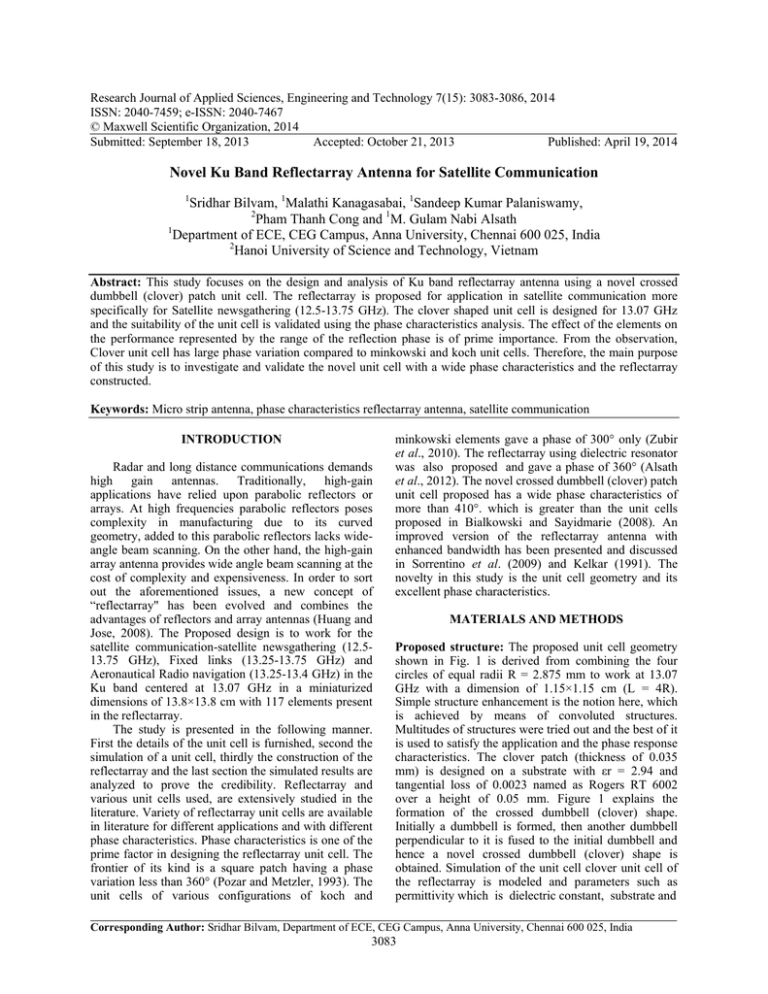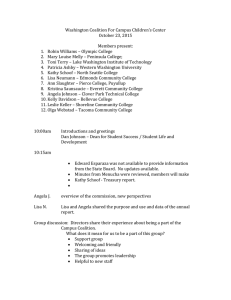Research Journal of Applied Sciences, Engineering and Technology 7(15): 3083-3086,... ISSN: 2040-7459; e-ISSN: 2040-7467
advertisement

Research Journal of Applied Sciences, Engineering and Technology 7(15): 3083-3086, 2014 ISSN: 2040-7459; e-ISSN: 2040-7467 © Maxwell Scientific Organization, 2014 Submitted: September 18, 2013 Accepted: October 21, 2013 Published: April 19, 2014 Novel Ku Band Reflectarray Antenna for Satellite Communication 1 Sridhar Bilvam, 1Malathi Kanagasabai, 1Sandeep Kumar Palaniswamy, 2 Pham Thanh Cong and 1M. Gulam Nabi Alsath 1 Department of ECE, CEG Campus, Anna University, Chennai 600 025, India 2 Hanoi University of Science and Technology, Vietnam Abstract: This study focuses on the design and analysis of Ku band reflectarray antenna using a novel crossed dumbbell (clover) patch unit cell. The reflectarray is proposed for application in satellite communication more specifically for Satellite newsgathering (12.5-13.75 GHz). The clover shaped unit cell is designed for 13.07 GHz and the suitability of the unit cell is validated using the phase characteristics analysis. The effect of the elements on the performance represented by the range of the reflection phase is of prime importance. From the observation, Clover unit cell has large phase variation compared to minkowski and koch unit cells. Therefore, the main purpose of this study is to investigate and validate the novel unit cell with a wide phase characteristics and the reflectarray constructed. Keywords: Micro strip antenna, phase characteristics reflectarray antenna, satellite communication INTRODUCTION Radar and long distance communications demands high gain antennas. Traditionally, high-gain applications have relied upon parabolic reflectors or arrays. At high frequencies parabolic reflectors poses complexity in manufacturing due to its curved geometry, added to this parabolic reflectors lacks wideangle beam scanning. On the other hand, the high-gain array antenna provides wide angle beam scanning at the cost of complexity and expensiveness. In order to sort out the aforementioned issues, a new concept of “reflectarray" has been evolved and combines the advantages of reflectors and array antennas (Huang and Jose, 2008). The Proposed design is to work for the satellite communication-satellite newsgathering (12.513.75 GHz), Fixed links (13.25-13.75 GHz) and Aeronautical Radio navigation (13.25-13.4 GHz) in the Ku band centered at 13.07 GHz in a miniaturized dimensions of 13.8×13.8 cm with 117 elements present in the reflectarray. The study is presented in the following manner. First the details of the unit cell is furnished, second the simulation of a unit cell, thirdly the construction of the reflectarray and the last section the simulated results are analyzed to prove the credibility. Reflectarray and various unit cells used, are extensively studied in the literature. Variety of reflectarray unit cells are available in literature for different applications and with different phase characteristics. Phase characteristics is one of the prime factor in designing the reflectarray unit cell. The frontier of its kind is a square patch having a phase variation less than 360° (Pozar and Metzler, 1993). The unit cells of various configurations of koch and minkowski elements gave a phase of 300° only (Zubir et al., 2010). The reflectarray using dielectric resonator was also proposed and gave a phase of 360° (Alsath et al., 2012). The novel crossed dumbbell (clover) patch unit cell proposed has a wide phase characteristics of more than 410°. which is greater than the unit cells proposed in Bialkowski and Sayidmarie (2008). An improved version of the reflectarray antenna with enhanced bandwidth has been presented and discussed in Sorrentino et al. (2009) and Kelkar (1991). The novelty in this study is the unit cell geometry and its excellent phase characteristics. MATERIALS AND METHODS Proposed structure: The proposed unit cell geometry shown in Fig. 1 is derived from combining the four circles of equal radii R = 2.875 mm to work at 13.07 GHz with a dimension of 1.15×1.15 cm (L = 4R). Simple structure enhancement is the notion here, which is achieved by means of convoluted structures. Multitudes of structures were tried out and the best of it is used to satisfy the application and the phase response characteristics. The clover patch (thickness of 0.035 mm) is designed on a substrate with εr = 2.94 and tangential loss of 0.0023 named as Rogers RT 6002 over a height of 0.05 mm. Figure 1 explains the formation of the crossed dumbbell (clover) shape. Initially a dumbbell is formed, then another dumbbell perpendicular to it is fused to the initial dumbbell and hence a novel crossed dumbbell (clover) shape is obtained. Simulation of the unit cell clover unit cell of the reflectarray is modeled and parameters such as permittivity which is dielectric constant, substrate and Corresponding Author: Sridhar Bilvam, Department of ECE, CEG Campus, Anna University, Chennai 600 025, India 3083 Res. J. App. Sci. Eng. Technol., 7(15): 3083-3086, 2014 Fig. 3: Reflectarray constructed in y-axis. The incident wave will propagates along zaxis whereas the E-field of the incident energy is polarized in y-axis and the H-field of the incident energy is polarized in x-axis. These boundary conditions are to make sure the unit cell receives incident energy from a plane wave. Figure 2 illustrates the example of simulated unit cell reflectarray with clover patch as a reflect element. Mesh cell or meshing size is very important parameter and has an impact on the accuracy and speed of the simulation. Another point of consideration is the port location and port mode. The port in the simulation will play an important role as an excitation source to capture the reflection, it is required to be located at least 0.25 λ from the unit cell in order to ensure reception of a normal incident wave (0°). The first mode or dominant mode which is TEM will be chosen to propagate and excite that unit cell of reflectarray (Zubir et al., 2010). Fig. 1: Proposed unit cell Fig. 2: Boundary conditions for the simulation of the unit cell copper thickness, tangential loss and geometry of radiating element are defined. Perfect Magnetic Conductor (PMC) boundary condition was setup on the left and right hand side of a unit cell reflectarray in xaxis and Perfect Electric Conductor (PEC) boundary condition was setup on the bottom and top of a unit cell RESULTS AND DISCUSSION Figure 3 shows the reflectarray constructed using the novel clover patch elements of variable sizes in order to overcome the individual path differences which lead to the phase differences when fed by a horn Fig. 4: Reflection coefficient S 11 of the clover unit cell having unit cell geometry of 1.15×1.15 cm2 3084 Res. J. App. Sci. Eng. Technol., 7(15): 3083-3086, 2014 Fig. 5: Reflection phase vs. radius of the clover unit cell Fig. 6: Reflectarray setup fed by horn Fig. 7: E-field radiation pattern antenna. The inter element distance between the two clover elements is taken to be equal to 0.5 times the free space wavelength which is equal to 1.15 mm. The dimensions of the reflectarray constructed are 13.8×13.8 cm. Full wave simulation is performed using EM solver. The reflection characteristic of the clover shape unit cell is illustrated in Fig. 4. The reflection coefficient of -0.693 dB is observed at 13.07 GHz. It can be concluded that the clover unit cell has a good 3085 Res. J. App. Sci. Eng. Technol., 7(15): 3083-3086, 2014 Table 1: Performance of clover reflectarray Parameters Phase range (deg.) Gain (dB) Side Lobe Level (SLL) -3 dB beam width (deg.) E field (dBV/m) REFERENCES Value 414 24.03 < -18.50 dB 5.60 39.14 return loss and therefore they can be considered as a good reflector as the reflection is more than 90%. Figure 5 shows the phase characteristics that are phase vs. radius parameter of the clover element. This witnesses the phase response obtained is more than 360° and the reflection phase ranges from 52°to -362° leading to a reflection phase of 414°. Figure 6 illustrates the excitation of the reflectarray using a horn antenna which is placed at a distance of 0.97 times the reflectarray dimensions that is at 13.386 cm (f/D = 0.97). Figure 7 shows the normalized E-Field pattern and it is noted that the (SLL) side lobe level is -18.5 dB, Angular width is 5.6° and from the analysis it is found that the directivity is 24.5 dBi and the gain is 24.03 dB. Table 1 summarizes the characteristics and features of the novel clover reflectarray. CONCLUSION A Ku band reflectarray antenna which has the features of novel unit cell and wide phase characteristics is discussed in this study. From the results, investigating the clover unit cell, it can be validated and may be called as a good reflector for the reflectarray with reflection more than 90% and provides a wide reflection phase greater than 410°. The feed arrays show deep SLL suppression, high gain and directivity which are suitable for the satellite communication. Further study should focus on improving the -3 dB Beam width, rigidity, reduction in the cost of the construction of the reflectarray and also the reduction of the back lobes using frequency selective surface as proposed in Ren et al. (2011a, b). Alsath, M.G.N., M. Kanagasabai and S. Arunkumar, 2012. Dual-band dielectric resonator reflectarray for C/X-bands. IEEE Antenn. Wirel. Pr., 11: 1253-1256. Bialkowski, M.E. and K.H. Sayidmarie, 2008. Phasing characteristics of a single layer microstrip reflectarray employing various basic element shapes. Proceeding of International Workshop on Antenna Technology: Small Antennas and Novel Metamaterials. Chiba, pp: 79-82. Huang, J. and A.C. Jose, 2008. Reflectarray Antenna. IEEE Press, Wiley, New York. Kelkar, A., 1991. FLAPS: Conformal phased reflecting surfaces. Proceeding of the IEEE National Radar Conference, Los Angeles, California, pp: 58-62. Pozar, D.M. and T.A. Metzler, 1993. Analysis of a reflectarray antenna using microstrip patches of variable size. Electron. Lett., 29: 657-658. Ren, L.S., Y.C. Jiao, F. Li, J.J. Zhao and G. Zhao, 2011a. A novel double-petal loop element for broadband reflectarray. Pr. Electromagn. Res. Lett., 20: 157-163. Ren, L.S., Y.C. Jiao, J.J. Zhao and F. Li, 2011b. RCS reduction for a FSS-backed reflectarray using a ring element. Pr. Electromagn. Res. Lett., 26: 115-123. Sorrentino, R., R. Vincenti Gatti and L. Marcaccioli, 2009. Recent advances on millimetre wave reconfigurable reflectarrays. Proceeding of the 3rd European Conference on Antennas and Propagation (EuCAP 2009), pp: 2527-2531. Zubir, F., M.K.A. Rahim, O.B. Ayop and H.A. Majid, 2010. Design and analysis of microstrip reflectarray antenna with Minkowski shape radiating element. Prog. Electromagn. Res. B, 24: 317-331. 3086



